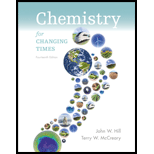
Concept explainers
Interpretation:
What happens to the oxidation number of one of its elements when a compound is oxidized and when it is reduced, must be explained.
Concept Introduction:
One of the ways to define oxidation and reduction involves gain or loss of electrons by elements during the reaction.
Here,
- Oxidation is loss of electrons.
- Reduction is gain of electrons.
For example, the reaction of magnesium with chlorine shown below:
Here, the oxidation state of magnesium in Mg(s) is zero and that in MgCl2 is 2+, thus, oxidation of Mg to Mg2+ results in increase in oxidation state. Similarly, the oxidation state of hydrogen in HCl is +1 and that in H2 is zero, reduction of hydrogen from HCl to H2 results in decrease in oxidation state.
Answer to Problem 1RQ
Solution:
Oxidation number of one of its elements is increased when a compound is oxidized.
Oxidation number of one of its elements is decreased when a compound is reduced.
Explanation of Solution
Oxidation number is defined as the charge present on a simple ion or atom.
In any reaction, reduction results due to gain of electron, if an atom or ion gain electrons it gets negative charge, or its negative charge increases. Thus, oxidation state of that atom decreases. Similarly, oxidation results due to loss of electron, if an atom or ion lose electrons it gets positive charge, or its positive charge increases.
Thus, oxidation number is increased during oxidation and it is decreased during reduction.
Want to see more full solutions like this?
Chapter 8 Solutions
Chemistry For Changing Times (14th Edition)
 ChemistryChemistryISBN:9781305957404Author:Steven S. Zumdahl, Susan A. Zumdahl, Donald J. DeCostePublisher:Cengage Learning
ChemistryChemistryISBN:9781305957404Author:Steven S. Zumdahl, Susan A. Zumdahl, Donald J. DeCostePublisher:Cengage Learning ChemistryChemistryISBN:9781259911156Author:Raymond Chang Dr., Jason Overby ProfessorPublisher:McGraw-Hill Education
ChemistryChemistryISBN:9781259911156Author:Raymond Chang Dr., Jason Overby ProfessorPublisher:McGraw-Hill Education Principles of Instrumental AnalysisChemistryISBN:9781305577213Author:Douglas A. Skoog, F. James Holler, Stanley R. CrouchPublisher:Cengage Learning
Principles of Instrumental AnalysisChemistryISBN:9781305577213Author:Douglas A. Skoog, F. James Holler, Stanley R. CrouchPublisher:Cengage Learning Organic ChemistryChemistryISBN:9780078021558Author:Janice Gorzynski Smith Dr.Publisher:McGraw-Hill Education
Organic ChemistryChemistryISBN:9780078021558Author:Janice Gorzynski Smith Dr.Publisher:McGraw-Hill Education Chemistry: Principles and ReactionsChemistryISBN:9781305079373Author:William L. Masterton, Cecile N. HurleyPublisher:Cengage Learning
Chemistry: Principles and ReactionsChemistryISBN:9781305079373Author:William L. Masterton, Cecile N. HurleyPublisher:Cengage Learning Elementary Principles of Chemical Processes, Bind...ChemistryISBN:9781118431221Author:Richard M. Felder, Ronald W. Rousseau, Lisa G. BullardPublisher:WILEY
Elementary Principles of Chemical Processes, Bind...ChemistryISBN:9781118431221Author:Richard M. Felder, Ronald W. Rousseau, Lisa G. BullardPublisher:WILEY





